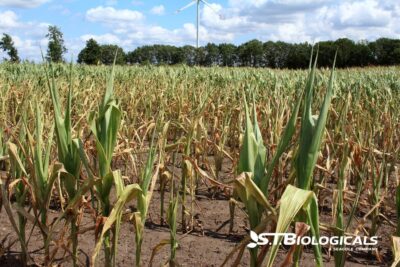Saline soil is a persistent challenge for farmers, reducing yields and inhibiting nutrient uptake. But regenerative agriculture offers a sustainable solution—leveraging microbes, micro nutrients, and foliar feeding to counteract salt stress while restoring soil health.
How Soil Microbes Reduce Salinity
What route is the most beneficial to reclaim your fields depends on how severe your salinity issues are. Salt-tolerant microbes can break down harmful compounds. Some bacteria even thrive in saline environments. We hope your situation isn’t that bad. If it is, your soil can be remediated.
Many bacteria are salt-tolerant, which means they can do their jobs and remediate saline despite the salt overload. Bacillus spp is known for improving soil health and nutrient cycling. Pseudomonas spp enhances plant growth by producing biofilms and solubilizing phosphorus. Rhizobium spp can help legumes fix nitrogen even under saline stress. Many other bacteria and fungi contribute to organic matter breakdown and disease suppression.
Fungi improve soil aggregation and enhance soil structure, preventing harmful salts from accumulating in the root zone. Better drainage flushes excess salts out, improving crop resilience.
Using biological amendments like microbial inoculants and compost helps replenish soils, increasing cation exchange capacity (CEC) for more effective nutrient cycling.
Micronutrients: Strengthening Crops Against Salt Stress
Saline soil often leads to micronutrient deficiencies, weakening plant health. Applying key micro nutrients ensures crops can thrive under challenging conditions:
- Calcium (Ca): Displaces sodium, restoring soil structure and improving water infiltration.
- Magnesium (Mg): Supports chlorophyll production and osmotic balance.
- Zinc (Zn) & Iron (Fe): Essential for enzymatic function and stress tolerance in saline conditions.
- Manganese (Mn) & Boron (B): Enhance root development and nutrient transport in salty soils.
Using microbial products in combination with nutrient applications makes those nutrients more available to plants and begins the remediation process of your saline soil. But are soil applications of microbes and nutrients the best value on your farm?
Why Foliar Feeding Outperforms Soil Applications in Saline Conditions
Traditional soil-applied fertilizers can get locked up by excessive salts, preventing efficient nutrient absorption. Foliar feeding bypasses this issue, delivering micronutrients directly to the plant’s vascular system for immediate uptake.
Key Benefits of Foliar Feeding in Regenerative Ag:
✔ Avoids Soil Fixation: Nutrients are absorbed through leaves, reducing waste from salt interference.
✔ Boosts Stress Tolerance: Micronutrient formulations improve drought and salt resilience.
✔ Increases Efficiency: Requires lower application rates, reducing environmental impact.
✔ Supports Regenerative Systems: Works alongside biological amendments to rebuild soil health.
Adding biology, Calcine (or Protos 32 Organic), and nutrients directly to your plants in a foliar spray gives them immediate access to those nutrients. Plants share with the soil biology, and the organic acids produced by the microbes in the plant find their way into the soil. Those acids break apart salt molecules, and the calcium nutrient added reassembles the amino acids into peptides with the help of the soil carbon. For a more in-depth explanation, go here.
What’s Our Regenerative Approach to Microbes, Nutrients, and Saline Soil?
We start with a soil test. Then we determine the limiting factor, or factors, for your field. We partner with Purple Cow Organics and use their LiquiLife+ to increase the microbial populations in your soil, a key to remediating any salinity issues. Because we know you can’t wait even a single year for the microbes to do their work, we recommend foliar spray with a biological/nutrient mix to kickstart plant growth.
We’ve invested years in research, so you don’t have to. We know three things to be true about saline soil:
- Microbial inoculants break down salts and restore soil function.
- Micronutrients enhance plant resilience, ensuring steady growth in saline conditions.
- Foliar feeding ensures direct nutrient absorption, bypassing soil limitations.
Farmers adopting regenerative practices like microbial soil solutions, micronutrient balancing, and foliar feeding are transforming marginal, salty land into thriving, productive fields—all while improving long-term soil health and sustainability.
Want to reduce soil salinity and boost yields naturally? Contact our team and learn how regenerative agriculture can work for your farm today. We’re here to help you succeed. When soil speaks, we listen.

